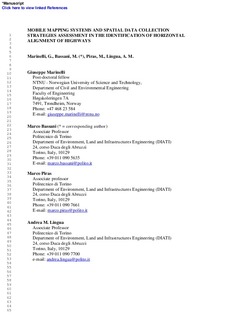| dc.contributor.author | Marinelli, Giuseppe | |
| dc.contributor.author | Bassani, Marco | |
| dc.contributor.author | Piras, Marco | |
| dc.contributor.author | Lingua, Andrea | |
| dc.date.accessioned | 2017-08-22T07:43:53Z | |
| dc.date.available | 2017-08-22T07:43:53Z | |
| dc.date.created | 2017-03-27T17:42:09Z | |
| dc.date.issued | 2017 | |
| dc.identifier.citation | Transportation Research Part C: Emerging Technologies. 2017, 79 257-273. | nb_NO |
| dc.identifier.issn | 0968-090X | |
| dc.identifier.uri | http://hdl.handle.net/11250/2451356 | |
| dc.description.abstract | The horizontal alignment of existing highways may be identified by using several terrestrial or aerial geomatics technologies. Such technologies involve different levels of precision and accuracy; hence, different results can be expected. At present, there are no comparisons available between the solutions resulting from the use of different technologies and data sources for the same road alignment. In this investigation, a number of terrestrial mobile mapping techniques and data collection strategies were evaluated. The centerline of a 3.6 km section of a highway was used to estimate radii, centers of curvature and orientation of tangents. Two statistical fitting methods were used to back calculate these parameters, and the results were then compared with as built alignment data. Terrestrial images from a mobile mapping vehicle were used to determine the centerline, which was also estimated as the average line of the carriageway and pavement edges, and as the average line of the two driving trajectories. Positions were surveyed using low-cost sensors (an integrated GPS-IMU platform, HD webcam). For comparison purposes, aerial orthophotos and a GNSS (high-cost) receiver were used simultaneously. Although the GPS IMU data and estimated trajectories provided results comparable to those of the GNSS receiver, the use of georeferenced images proved less accurate. The results and comments in the paper should be of use to survey practitioners when they need to select an acquisition methodology appropriate to the desired level of accuracy and in line with budget constraints. | nb_NO |
| dc.language.iso | eng | nb_NO |
| dc.publisher | Elsevier | nb_NO |
| dc.subject | Veiplanlegging | nb_NO |
| dc.subject | Road planning | nb_NO |
| dc.subject | Veginfrastruktur | nb_NO |
| dc.subject | Road infrastructure | nb_NO |
| dc.title | Mobile Mapping Systems and Spatial Data Collection Strategies in the Identification of Horizontal Alignment of Highways | nb_NO |
| dc.type | Journal article | nb_NO |
| dc.type | Peer reviewed | nb_NO |
| dc.description.version | submittedVersion | nb_NO |
| dc.subject.nsi | VDP::Miljøteknologi: 610 | nb_NO |
| dc.subject.nsi | VDP::Environmental engineering: 610 | nb_NO |
| dc.source.pagenumber | 257-273 | nb_NO |
| dc.source.volume | 79 | nb_NO |
| dc.source.journal | Transportation Research Part C: Emerging Technologies | nb_NO |
| dc.identifier.doi | 10.1016/j.trc.2017.03.020 | |
| dc.identifier.cristin | 1461519 | |
| dc.description.localcode | This is the authors' manuscript to the article (preprint). | nb_NO |
| cristin.unitcode | 194,68,20,30 | |
| cristin.unitname | Institutt for bygg og miljø | |
| cristin.ispublished | true | |
| cristin.fulltext | original | |
| cristin.fulltext | preprint | |
| cristin.qualitycode | 1 | |
